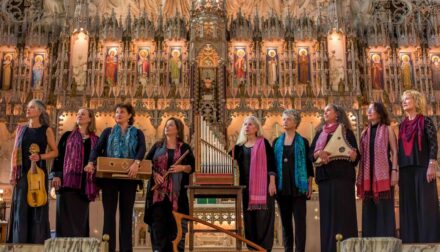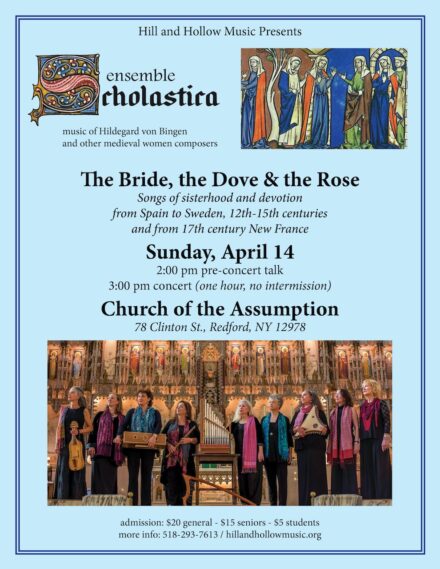Female Voices Perform Medieval Plainchant and Polyphony

 Hildegard von Bingen and other medieval women composers
Hildegard von Bingen and other medieval women composers
Ensemble Scholastica performs in concert on Sunday, April 14 at 3:00 pm at the historic Church of the Assumption in Redford, New York. There is a pre-concert talk at 2:00 pm by ensemble director Rebecca Bain about the medieval period and the culture of the cloister. General admission at the door: general $20; seniors $15; and students $5.
Founded in 2008, Ensemble Scholastica is Canada’s only female vocal ensemble specializing in the performance of Gregorian chant and medieval polyphony (c. 800-1300 AD). Ensemble members are professional vocalists from Montréal’s thriving early music community, some playing medieval instruments. Leading medievalist Rebecca Bain has been the Director of Scholastica since 2012.
They study and sing from the original sources of medieval manuscripts, yet with the added freedom of “elaboration” (ornamentation and improvisation). The resulting interpretations illustrate the surprising rhythmic variety and melodic richness of medieval chant and capture the fluidity and interplay of the melodic lines of medieval polyphony. Their goal is to offer audiences the opportunity to experience the remarkable joy and complexity of medieval spirituality and culture and to share with listeners the beauty and intricacy of medieval music and liturgical traditions at the very root of Western music.
Ensemble Scholastica is named after St. Scholastica, the 6th-century woman who was the sister of St. Benedict, founder of the Benedictine Order. Although that of her brother has eclipsed Scholastica’s renown, she was the founder of the female branch of that immensely influential institution, which was responsible for the creation and dissemination of an extensive body of music over many centuries. Monastic orders historically offered women a chance to receive an education, develop various skills (including singing!) and make a difference in their communities.
Celebrating this legacy, nine female singers (some also play period instruments) will present works composed, collected and/or sung by women in their convents and lay communities in medieval Europe. This tradition thrived well into the early modern era and onto other continents, notably New France in North America and in Latin America. With lyrics rich in symbolism, the program offers an intimate look at the desires and devotions of this sisterhood of eternal brides whose very real contributions have been largely ignored by history.
The April 14 program is entitled “The Bride, the Dove and the Rose.” The “bride” symbolizes the church and its people, while the bridegroom symbolizes God and/or Jesus; the “dove” symbolizes the holy spirit-mediator and consoler; and the “rose” symbolizes Jesus Christ and/or Mary, the ultimate female role model. These intertwining elements would have been understood as referring to God’s love for his people. For those who chose the monastic life, this was a deeply personal expression of their desire for union with Christ.
The program features works of Hildegard von Bingen (1098-1179), one of the most recognizable medieval women, famous for her visionary writings and paintings, medical treatises, as well as over 70 musical compositions. Hildegard’s voice was highly original, offering a distinctly female perspective; and many of her songs were dedicated to Mary.
The program includes works from the Speculum virginum, a 12th-century treatise on female monastic life that was used widely in Germanic convents until the Reformation; works from the Las Huelgas Codex, one of Spain’s largest collections of medieval music, representing the 13th century repertoire at the important convent of Santa Maria la Real de Las Huelgas; works from the Cantus Sororum, a prayer service created by the Birgittine Order in Sweden in the 14th century, and the only Office established by and exclusively for women’s use; and works from the songbook of Anna of Cologne, a manuscript of Latin and German-texted sacred works collected for use by religious communities of female laity in the late 15th century.
Notable also on the program are works from the archives of the Congrégation Notre-Dame de Montréal, founded in the 17th century by Marguerite Bourgeoys (1620-1700), whose main mission was to educate young girls, the poor, and children of First Nations of Ville-Marie (now known as Montréal).
For further information, telephone 518-293-7613, e-mail ambrown.hillholl@gmail.com or visit hillandhollowmusic.org
Posted: April 5th, 2024 under Arts and Entertainment, Northern NY News, Religious News.
